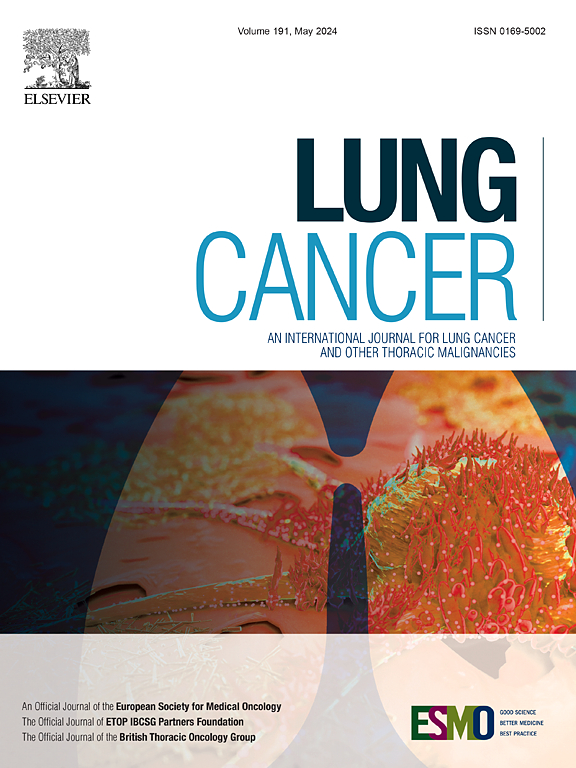临床因素和分子共改变影响接受一线奥西替尼治疗egfr突变非小细胞肺癌患者的预后。
IF 4.4
2区 医学
Q1 ONCOLOGY
引用次数: 0
摘要
目的:直到最近,奥西替尼仍是几乎所有egfr突变晚期NSCLC患者的首选一线治疗药物。然而,随着FLAURA2和MARIPOSA方案的批准,识别给一线奥西替尼带来更高不良结果风险的分子或临床因素可能更好地为新诊断患者的前期治疗选择提供信息。方法:这项现实世界的多中心回顾性研究横跨4个美国学术中心,纳入了接受一线奥西替尼单药治疗的转移性非小细胞肺癌和经典致敏性EGFR突变(外显子19缺失,L858R突变)的成年患者,这些患者在诊断时进行了基于组织的下一代测序。奥西替尼治疗停药时间(TTD)和总生存期(OS)的生存分析是通过共改变的数量、个体基因改变、先前定义的分子途径和临床因素进行的。结果:共纳入219例患者(中位年龄68岁,62%为女性,51%为基线中枢神经系统转移)。最常见的共改变是TP53(58%),其次是EGFR扩增(13%)、CDKN2A(10%)、RB1(9%)和PIK3CA(8%)。新生共改变的数量和分子途径共改变的存在对TTD或OS没有显著的预测作用。与TP53和PIK3CA野生型人群相比,TP53和PIK3CA共同改变(而非TP53单独改变)的中位生存期显著缩短(21.9个月vs 39.5个月,p = 0.046),中位TTD的数值趋势相似。在多变量分析中,L858R突变、中枢神经系统和骨转移仍然是不良临床结果的重要预测因素。结论:TP53和PIK3CA的共改变可能是egfr突变NSCLC的高危分子亚群,但在进行风险分层时应同时考虑临床和分子特征。本文章由计算机程序翻译,如有差异,请以英文原文为准。
Clinical factors and molecular co-alterations impact outcomes in patients receiving first-line osimertinib for EGFR-mutated non-small cell lung cancer
Purpose
Until recently, osimertinib was the preferred first-line therapy for nearly all patients with EGFR-mutated advanced NSCLC. However, with approval of the FLAURA2 and MARIPOSA regimens, identifying molecular or clinical factors that confer higher risk for inferior outcomes to first-line osimertinib may better inform upfront treatment selection for newly-diagnosed patients.
Methods
This real-world, multicenter retrospective study across 4 U.S. academic centers included adult patients with metastatic NSCLC and classic sensitizing EGFR mutations (exon 19 deletion, L858R mutation) receiving first-line osimertinib monotherapy who had tissue-based next-generation sequencing performed at diagnosis. Survival analyses for time-to-treatment discontinuation (TTD) on osimertinib and overall survival (OS) were conducted by number of co-alterations, individual gene alterations, previously defined molecular pathways, and clinical factors.
Results
A total of 219 patients were included (median age 68, 62 % female, 51 % with baseline CNS metastases). TP53 was most frequently co-altered (58 %), followed by EGFR amplification (13 %), CDKN2A (10 %), RB1 (9 %), and PIK3CA (8 %). Number of de novo co-alterations and presence of co-alterations by molecular pathway did not significantly predict TTD or OS. Co-alteration of both TP53 and PIK3CA, but not TP53 alone, demonstrated significantly shorter median OS compared to the TP53 and PIK3CA wild-type population (21.9 vs 39.5 months, p = 0.046), with similar numerical trend for median TTD. On multivariate analysis, L858R mutation and CNS and bone metastases remained significant predictors for inferior clinical outcomes.
Conclusion
Co-alteration of TP53 and PIK3CA may represent a high-risk molecular subgroup of EGFR-mutated NSCLC, however both clinical and molecular features should be considered in risk stratification.
求助全文
通过发布文献求助,成功后即可免费获取论文全文。
去求助
来源期刊

Lung Cancer
医学-呼吸系统
CiteScore
9.40
自引率
3.80%
发文量
407
审稿时长
25 days
期刊介绍:
Lung Cancer is an international publication covering the clinical, translational and basic science of malignancies of the lung and chest region.Original research articles, early reports, review articles, editorials and correspondence covering the prevention, epidemiology and etiology, basic biology, pathology, clinical assessment, surgery, chemotherapy, radiotherapy, combined treatment modalities, other treatment modalities and outcomes of lung cancer are welcome.
 求助内容:
求助内容: 应助结果提醒方式:
应助结果提醒方式:


